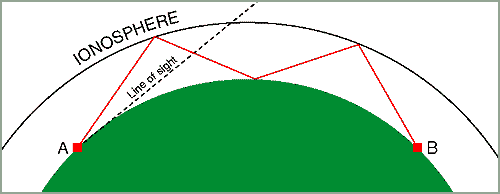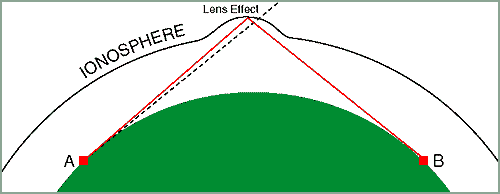

|
The official HAARP facility is located in Gakuna, Alaska. The site consists of a collection of antennae, arranged in a computer-controlled grid, known as a "phased array." A phased array has the ability to focus radio signals in a precise direction, without the necessity of turning the antennae. Modern radar systems no longer use the revolving dish that we have come to recognize. The new radar antennae, which rely on phased arrays, look more like the flat screen of a drive-in movie, speckled with small umbrella-like antennae in neat rows. The phased array in HAARP is not a radar, but it uses some of the same extremely high frequencies to focus a powerful radio beam to specific locations in the Earth's ionosphere.

The ionosphere is a layer of charged particles (or "ions") located about 60-90 kilometers above the Earth's surface. It is the layer which reflects short wave radio waves and makes it possible for a transmitter in New York to send a signal to Tokyo. Short waves may be good enough to send The Voice of America broadcasts, but they are subject to noise and static. Short wave signals lose much of their power as they travel and can even be blocked by the weather and sunspot activity.
Extremely High Frequency waves, on the other hand, are much shorter than short waves. They travel in compact, narrowly focused, beams. They do not encounter static or deteriorate from rain or clouds. Since they retain their strength over long distances, they are preferred for most point-to-point communications. Unfortunately, though, EHF waves (including microwaves) do not naturally reflect and bounce off of the ionosphere. For this reason, high frequency waves are said to propagate along the "line of sight." If you own a satellite television dish, you know that it is important for your antenna to be pointed in the direction of the satellite. This is because you are receiving extremely high frequency waves.
 Eastlund's discovery involved beaming High Frequency (HF) and Extremely High Frequency (EHF) waves, of extremely high power (over a billion watts), directly at a point on the ionosphere. When this was done, the ionosphere became heated from the accumulating electrical energy. You might think of it as "cooking" the atmosphere. The heated portion of the ionosphere expands like heated plastic and is raised to a higher altitude, causing an atmospheric "bulge." Eastlund discovered that this bulge was highly reflective to radio waves, and, because of its altitude, it could bounce high frequency radio signals to points well beyond the horizon. Even efficient ELF and microwaves signals, which normally would pass through the ionosphere into space, could be deflected without much loss of strength. He called this heated "bulge" the "lens effect." Eastlund's first patent (US #4,686,605) was for a "method and apparatus for altering a region in the Earth's atmosphere, ionosphere, and or magnetosphere." His second patent described the reflection of a second signal, using the ionospheric bulge, to distant locations on the Earth's surface. Eastlund had been working with the Atlantic Richfield Company, holders of a massive reserve of natural gas under Alaska's north slope. ARCO bought Eastlund's first two patents with the understanding that this new technology would make it possible for their natural gas reserves, too expensive to be piped from Alaska, to be converted to electrical energy on the north slope, and then bounced off the heated ionosphere to customers in remote locations around the globe. Also, because Eastlund's "heaters" could elevate the Earth's ionosphere, his discovery provided the ability to control weather! Jet streams could be altered, tornadoes could be zapped and rain could be made-- anywhere and anytime-- right here and right now! But the military had other plans. Eastlund's patents were sealed under a US Secrecy Order. The military realized that his first patent outlined the recipe for an over-the-horizon radar apparatus, capable of detecting Soviet launched ICBM's within seconds of their launch. His second patent was even more appetizing. President Ronald Regan's infamous Star Wars program had challenged the military with tall order. Their complex laser systems, nuke satellites and rail-guns didn't work. The military were years from meeting Pentagon goals. Now, unexpectedly, their prayers had been answered. Eastlund's "energy transmission system" would be turned into the ultimate "death ray."
To determine the "length" of this frequency, or "wavelength," we simply divide the velocity of light, 300,000,000 meters per second, by the frequency, say 15,000,000 cycles per second, to arrive at a distance in meters. Thus, 15 MHz would equal 20 meters. The length of a radio antenna is determined by the frequency that it is designed to transmit or receive. In the case above (15 MHz), the ideal length of a long wire antenna would be 20 meters. However, this is not always practical. Engineers have found that they can successfully divide the length in half, or in a quarter of the full wavelength, and still maintain both transmission and reception of the prescribed signal frequency. If one uses this formula to determine the wavelength of ELF signals, which range from 30 to 3000 hertz, one can easily see why extremely long antennae are needed, as pictured in Viewzone's Unusual Photograph of January 1999, even if a quarter wavelength is used. |